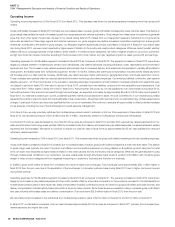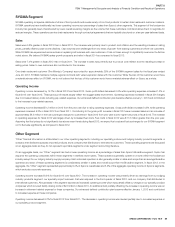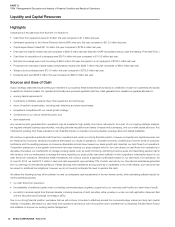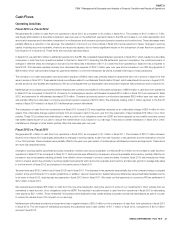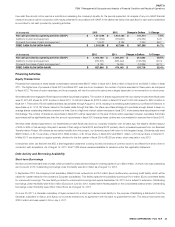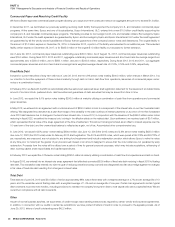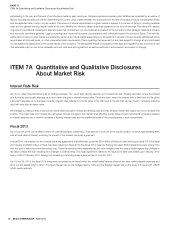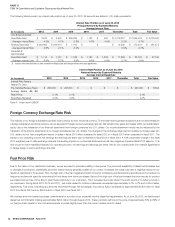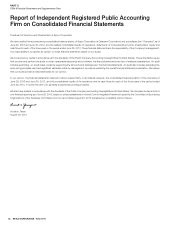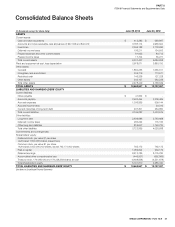Sysco 2013 Annual Report Download - page 49
Download and view the complete annual report
Please find page 49 of the 2013 Sysco annual report below. You can navigate through the pages in the report by either clicking on the pages listed below, or by using the keyword search tool below to find specific information within the annual report.SYSCO CORPORATION-Form10-K38
PARTII
ITEM7Management’s Discussion and Analysis of Financial Condition and Results of Operations
In addition, annually in our fourth quarter or more frequently as needed, we assess the recoverability of goodwill and inde nite-lived intangibles by determining
whether the fair values of the applicable reporting units exceed the carrying values of these assets. The reporting units used in assessing goodwill
impairment are our ten operating segments as described in Note21, “Business Segment Information,” to the Consolidated Financial Statements in Item8.
The components within each of our ten operating segments have similar economic characteristics and therefore are aggregated into ten reporting units.
We arrive at our estimates of fair value using a combination of discounted cash ow and earnings multiple models. The results from each of these models
are then weighted and combined into a single estimate of fair value for each of our ten operating segments. We use a 60% weighting for our discounted
cash ow valuation and 40% for the earnings multiple models giving greater emphasis to our discounted cash ow model because the forecasted operating
results that serve as a basis for the analysis incorporate management’s outlook and anticipated changes for the businesses consistent with a market
participant. The primary assumptions used in these various models include estimated earnings multiples of comparable acquisitions in the industry including
control premiums, earnings multiples on acquisitions completed by Sysco in the past, future cash ow estimates of the reporting units, which are dependent
on internal forecasts and projected growth rates, and weighted average cost of capital, along with working capital and capital expenditure requirements.
When possible, we use observable market inputs in our models to arrive at the fair values of our reporting units. We update our projections used in our
discounted cash ow model based on historical performance and changing business conditions for each of our reporting units.
Our estimates of fair value contain uncertainties requiring management to make assumptions and to apply judgment to estimate industry economic factors
and the pro tability of future business strategies. Actual results could differ from these assumptions and projections, resulting in the company revising its
assumptions and, if required, recognizing an impairment loss. There were no impairments of goodwill or inde nite-lived intangibles recorded as a result of
assessment in scal 2013,2012 or2011. Our past estimates of fair value for scal 2012 and 2011 have not been materially different when revised to include
subsequent years’ actual results. Sysco has not made any material changes in its impairment assessment methodology during the past three scal years.
We do not believe the estimates used in the analysis are reasonably likely to change materially in the future but we will continue to assess the estimates
in the future based on the expectations of the reporting units. In the scal 2013 analysis our estimates of fair value did not require additional analysis;
however, we would have performed additional analysis to determine if an impairment existed for the following reporting units if our estimates of fair value
were decreased by the following amounts. First, our specialty produce operations would have required additional analysis if the estimated fair value had
been 30% lower. Second, our European Broadline company would have required additional analysis if the estimated fair value had been 37% lower. As
ofJune29,2013, these two reporting units had goodwill aggregating $381.0million. For the remainder of our reporting units, which as ofJune29,2013
had goodwill aggregating $1.5billion, we would have performed additional analysis to determine if an impairment existed for a reporting unit if the estimated
fair value for any of these reporting units had declined by greater than 48%.
Certain reporting units (Caribbean Broadline, European Broadline, specialty produce, custom-cut meat, lodging industry products, imported specialty
products and international distribution operations) have a greater proportion of goodwill recorded to estimated fair value as compared to the UnitedStates
Broadline, Canadian Broadline or SYGMA reporting units. This is primarily due to these businesses having been more recently acquired, and as a result
there has been less history of organic growth than in the UnitedStates Broadline, Canadian Broadline and SYGMA reporting units. In addition, these
businesses also have lower levels of cash ow than the UnitedStates Broadline reporting unit. As such, these reporting units have a greater risk of future
impairment if their operations were to suffer a signi cant downturn.
Share-Based Compensation
We provide compensation bene ts to employees and non-employee directors under several share-based payment arrangements including various employee
stock incentive plans, the Employees’ Stock Purchase Plan, the Management Incentive Plan and various non-employee director plans.
As of June29,2013, there was $69.4million of total unrecognized compensation cost related to share-based compensation arrangements. That cost is
expected to be recognized over a weighted-average period of 2.41 years.
The fair value of each option award is estimated on the date of grant using a Black-Scholes option pricing model. Expected volatility is based on historical
volatility of Sysco’s stock, implied volatilities from traded options on Sysco’s stock and other factors. We utilize historical data to estimate option exercise
and employee termination behavior within the valuation model; separate groups of employees that have similar historical exercise behavior are considered
separately for valuation purposes. Expected dividend yield is estimated based on the historical pattern of dividends and the average stock price for the year
preceding the option grant. The risk-free rate for the expected term of the option is based on the U.S. Treasury yield curve in effect at the time of grant.
The fair value of each restricted stock unit award granted with a dividend equivalent is based on the company’s stock price as of the date of grant. For
restricted stock units granted without dividend equivalents, the fair value is reduced by the present value of expected dividends during the vesting period.
The fair value of the stock issued under the Employee Stock Purchase Plan is calculated as the difference between the stock price and the employee
purchase price.
The fair value of restricted stock granted to employees is based on the stock price on grant date. The application of a discount to the fair value of a restricted
stock grant is dependent upon whether or not each individual grant contains a post-vesting restriction.


